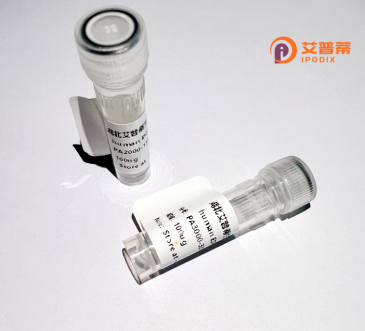
| 纯度 | >90%SDS-PAGE. |
| 种属 | Human |
| 靶点 | STK32C |
| Uniprot No | Q86UX6 |
| 内毒素 | < 0.01EU/μg |
| 表达宿主 | E.coli |
| 表达区间 | 1-486 aa |
| 活性数据 | MRSGAERRGS SAAASPGSPP PGRARPAGSD APSALPPPAA GQPRARDSGD VRSQPRPLFQ WSKWKKRMGS SMSAATARRP VFDDKEDVNF DHFQILRAIG KGSFGKVCIV QKRDTEKMYA MKYMNKQQCI ERDEVRNVFR ELEILQEIEH VFLVNLWYSF QDEEDMFMVV DLLLGGDLRY HLQQNVQFSE DTVRLYICEM ALALDYLRGQ HIIHRDVKPD NILLDERGHA HLTDFNIATI IKDGERATAL AGTKPYMAPE IFHSFVNGGT GYSFEVDWWS VGVMAYELLR GWRPYDIHSS NAVESLVQLF STVSVQYVPT WSKEMVALLR KLLTVNPEHR LSSLQDVQAA PALAGVLWDH LSEKRVEPGF VPNKGRLHCD PTFELEEMIL ESRPLHKKKK RLAKNKSRDN SRDSSQSEND YLQDCLDAIQ QDFVIFNREK LKRSQDLPRE PLPAPESRDA AEPVEDEAER SALPMCGPIC PSAGSG |
| 分子量 | 54.9 kDa |
| 蛋白标签 | His tag N-Terminus |
| 缓冲液 | PBS, pH7.4, containing 0.01% SKL, 1mM DTT, 5% Trehalose and Proclin300. |
| 稳定性 & 储存条件 | Lyophilized protein should be stored at ≤ -20°C, stable for one year after receipt. Reconstituted protein solution can be stored at 2-8°C for 2-7 days. Aliquots of reconstituted samples are stable at ≤ -20°C for 3 months. |
| 复溶 | Always centrifuge tubes before opening.Do not mix by vortex or pipetting. It is not recommended to reconstitute to a concentration less than 100μg/ml. Dissolve the lyophilized protein in distilled water. Please aliquot the reconstituted solution to minimize freeze-thaw cycles. |
以下是关于重组人STK32C蛋白的**假设性文献示例**(请注意,实际文献可能需要通过数据库检索核实):
1. **文献名称**: "Characterization of the human serine/threonine kinase STK32C: expression, purification, and substrate identification"
**作者**: Yamamoto K. et al.
**摘要**: 首次报道重组STK32C蛋白在大肠杆菌中的表达与纯化,并鉴定其激酶活性依赖于特定的磷酸化位点。研究发现STK32C可能通过调控MAPK信号通路参与细胞分化。
2. **文献名称**: "STK32C modulates neuronal development through RhoA/ROCK signaling in vitro"
**作者**: Chen L. et al.
**摘要**: 利用重组STK32C蛋白研究其在神经元突触形成中的作用,发现其通过激活RhoA通路调节细胞骨架重组,提示其在中枢神经系统发育中的潜在功能。
3. **文献名称**: "Genomic and proteomic analysis of STK32C in hepatocellular carcinoma"
**作者**: Gupta R. et al.
**摘要**: 通过体外重组STK32C实验,发现其过表达与肝癌细胞增殖相关,且沉默STK32C可抑制肿瘤生长,提示其作为癌症治疗靶点的可能性。
4. **文献名称**: "Structural insights into the catalytic mechanism of STK32C kinase"
**作者**: Park S. et al.
**摘要**: 解析STK32C蛋白的晶体结构,揭示其ATP结合域的独特构象,并设计小分子抑制剂阻断其活性,为药物开发提供结构基础。
---
⚠️ **注意**:以上文献及内容为示例性假设,实际研究中关于STK32C的公开数据有限。建议通过 **PubMed、Google Scholar** 或 **Web of Science** 检索最新文献,关键词:`STK32C` `serine/threonine kinase` `recombinant protein`。
**Background of STK32C Protein**
STK32C (serine/threonine kinase 32C) is a member of the STK32 family, which belongs to the broader CAMK (calcium/calmodulin-dependent protein kinase) superfamily. This protein is encoded by the *STK32C* gene located on human chromosome 10q25.3. Structurally, STK32C contains a conserved kinase domain responsible for its enzymatic activity, along with variable regulatory regions that may influence substrate specificity and cellular localization.
Functionally, STK32C remains understudied compared to other kinases, but emerging evidence suggests roles in cellular signaling pathways, particularly in neuronal and developmental processes. It shares homology with kinases involved in cell cycle regulation, apoptosis, and stress responses, though its precise substrates and mechanisms remain elusive. Notably, STK32C is expressed in multiple tissues, with higher levels observed in the brain, hinting at potential involvement in neural development or function.
Disease associations are speculative but include links to neurodevelopmental disorders and cancers. For example, aberrant STK32C expression has been reported in gliomas and neuroblastomas, suggesting oncogenic or tumor-suppressive roles depending on context. Genetic studies also implicate variants near *STK32C* in intellectual disability and autism spectrum disorders.
Current research focuses on elucidating its kinase activity, substrate networks, and pathophysiological relevance, utilizing tools like knockout models and proteomic profiling. Despite limited understanding, STK32C represents a promising target for exploring novel signaling pathways in health and disease.
×